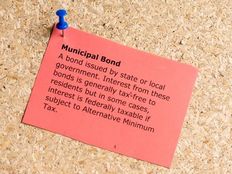
Most investors purchasing municipal bonds plan on receiving semiannual interest payments until a maturity date when the principal is paid off, but in some cases, muni bonds don’t make any interest payments at all. Zero coupon muni bonds are issued at a discount to face value and the investor receives the full value plus accrued interest all at once at maturity. While these bonds may seem unconventional, there are many reasons investors might appreciate them.
Below, MunicipalBonds.com takes a closer look at zero coupon muni bonds and some important considerations for investors using them.
Types of Zero Coupon Muni Bonds
There are two primary types of zero coupon municipal bonds: convertible zero coupon muni bonds and stripped muni bonds.
Convertible zero coupon muni bonds are sold as traditional zero coupon bonds that convert to interest-paying bonds after 10 to 15 years. Since these bonds are issued at a discount, investors can purchase them for a lower price during their working years and generate tax-free income. The conversion feature can then generate consistent and reliable retirement income after the bond is converted many years later.
Stripped muni bonds are traditional bonds that have been stripped of their coupon payments and repackaged into zero coupon bonds where only the principal is repaid at maturity. While these aren’t technically classified as zero coupon bonds, they behave in much the same way and provide investors with a way to acquire bonds at a discount early on and realize the full face value down the road when the maturity date comes.
Benefits of Zero Coupon Muni Bonds
Zero coupon municipal bonds have a number of benefits compared to traditional muni bonds that investors may want to carefully consider.
The largest benefit of zero coupon muni bonds is the low minimum investment since the securities are sold at a discount to face value. For example, a bond with a face value of $10,000 that matures in 20 years with a 5.5% coupon may be purchased for less than $5,000. This means that investors can purchase more face value at a lower upfront expense, which is ideal when saving money early in life when the interest income isn’t necessarily needed.
Another key benefit of zero coupon muni bonds is protection from reinvestment risk. The problem with traditional bonds is that investors must reinvest the semiannual interest payments at potentially lower interest rates. Since investors can lock in a specific rate of return with zero coupon bonds, they are spared from worrying about reinvesting the capital at a later date and thereby avoid any reinvestment risks.
Drawbacks of Zero Coupon Muni Bonds
Though we’ve just explained the advantages of zero coupon municipal bonds, there are still some drawbacks to consider.
The most obvious drawback of zero coupon muni bonds is that they do not pay semiannual interest to bondholders. While this interest still accrues on the investment, some investors rely on interest payments to meet their monthly expenses. These investors may want to consider more traditional muni bonds that do offer these regular payments or perhaps incorporating zero coupon bonds as only a portion of a diversified income portfolio.
A second key drawback is that the investor is tied to a specific interest rate. While this reduces reinvestment risk, investors also risk missing out on favorable changes in interest rates. These are important considerations for long-term bonds in particular since their higher duration increases these risks over time. Medium-term bonds may be the best option for investors looking to avoid these risks, or they could also consider laddering the bonds.
The Bottom Line
Zero coupon municipal bonds may not be as common as traditional muni bonds, but investors may find a place for them in their portfolios. Since they are sold at a discount to face value, investors can accumulate more of them early on and realize the tax benefits over time. Investors miss out on semiannual interest payments over time, but the value compounds and is paid in a lump sum at maturity, which may be a great tool for those saving for retirement.






